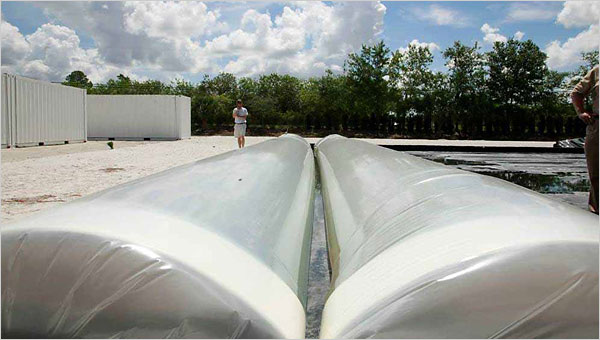Algae Farm Aims to Turn Carbon Dioxide Into Fuel

Algenol grows algae in troughs filled with saltwater that becomes saturated with carbon dioxide.
Because algae does not require any farmland or much space, many
energy companies are trying to use it to make commercial quantities of
hydrocarbons for fuel and chemicals. But harvesting the hydrocarbons has
proved difficult so far.
The ethanol would be sold as fuel, the companies said, but Dow’s long-term
interest is in using it as an ingredient for plastics, replacing natural
gas. The process also produces oxygen, which could be used to burn coal in a
power plant cleanly, said Paul Woods, chief executive of Algenol, which is
based in Bonita Springs, Fla. The exhaust from such a plant would be mostly
carbon dioxide, which could be reused to make more algae.
“We give them the oxygen, we get very pure carbon dioxide, and the output is
very cheap ethanol,” said Mr. Woods, who said the target price was $1 a
gallon.
Algenol grows algae in “bioreactors,” troughs covered with flexible plastic
and filled with saltwater. The water is saturated with carbon dioxide, to
encourage growth of the algae. “It looks like a long hot dog balloon,” Mr.
Woods said.
Dow, a maker of specialty plastics, will provide the “balloon” material.
The algae, through photosynthesis, convert the carbon dioxide and water into
ethanol, which is a hydrocarbon, oxygen and fresh water.
The company has 40 bioreactors in Florida, and as part of the demonstration
project plans 3,100 of them on a 24-acre site at Dow’s Freeport, Tex., site.
Among the steps still being improved is the separation of the oxygen and
water from the ethanol. The Georgia Institute of Technology will work on
that process, as will Membrane Technology and Research, a company in Menlo
Park, Calif. The National Renewable Energy Laboratory, an Energy Department
lab, will study carbon dioxide sources and their impact on the algae
samples.
Algenol and its partners are planning a demonstration plant that could
produce 100,000 gallons a year. The company and its partners were spending
more than $50 million, said Mr. Woods, but not all of that was going into
the pilot plant. The company had applied to the Energy Department for
financing under the stimulus bill, but would build a pilot plant with or
without a grant, he said.
With a stimulus grant, he said, the division of spending would be slightly
more than 50 percent from the private sector, although the normal level was
20 percent. The project would create 300 jobs, he said, adding that Algenol
and Dow were “incredibly hopeful” of getting the grant, partly because they
had a combination of an innovative start-up company, a major company with
extensive experience in industrial processes, a university and a national
laboratory.
At Dow, Peter A. Molinaro, a spokesman, said that the ethanol was
“intriguing to us as a feedstock, because the chemistry is simple.” Dow is
already working on using ethanol from Brazilian sugar cane as a replacement
for natural gas as an ingredient in plastics.
When Congress created a tax subsidy for ethanol, it raised the price for
nonfuel users like Dow, he said. “We’re looking at options, and this is
one,” he said.